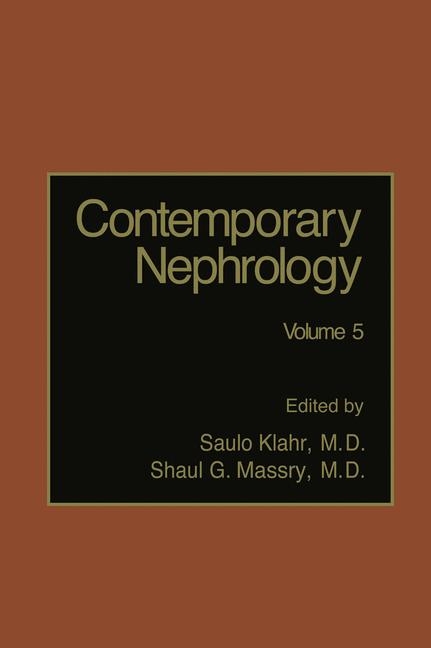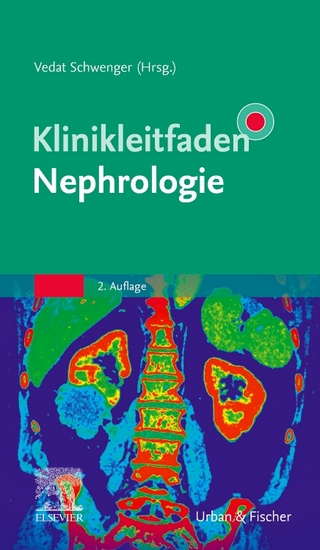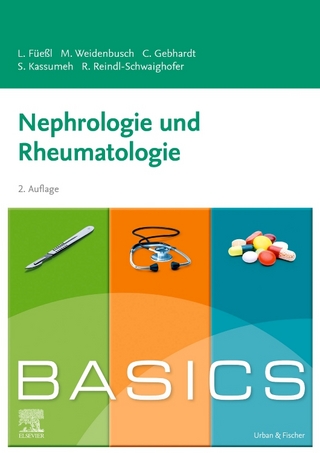
Contemporary Nephrology
Kluwer Academic/Plenum Publishers (Verlag)
978-0-306-43274-3 (ISBN)
- Titel ist leider vergriffen;
keine Neuauflage - Artikel merken
The immunological aspects of renal disease are clearly discussed by Dr. Couser in Chapter 7. New developments in this field are emphasized and should provide the reader with a clear understanding of the direction in which this field is moving. Drs. Humes and Messana (Chapter 8) discuss selected areas in which new developments have occurred in our understand- ing of acute renal failure and toxic nephropathy.
1:Water Transport across ADH-Sensitive Epithelia.- 1. Introduction.- 2. A Working Hypothesis.- 2.1. The Control Condition.- 2.2. The Action of ADH.- 3. Biochemical Aspects of the Mechanism of Action of ADH.- 3.1. ADH Receptors.- 3.2. Adenylate Cyclase.- 3.3. Cyclic AMP-Dependent Protein Kinase and Protein Phosphorylation.- 3.4. Modulators of the Hydrosmotic Response.- 4. Biophysics of Osmotic Water Flow.- 4.1. Water Transport by Solubility-Diffusion.- 4.2. Water Transport via Aqueous Pores.- 4.3. Water Transport via Narrow (Single-File) Pores.- 4.4. Effects of Unstirred Layers.- 4.5. Solvent Drag.- 5. Experimental Bases for the Pore Hypothesis of Water Permeation.- 5.1. Studies Based on Measurements of Transepithelial Osmotic Water Flow.- 5.2. Studies of Osmotic Water Permeability of Single Cell Membranes.- 5.3. The Pathway for Water Permeation.- 6. Role of the Cytoskeleton and Modulation of the Hydrosmotic Effect of ADH.- 7. Other Barriers to Osmotic Water Flow.- 8. Remaining Questions and Future Directions.- References.- 2:Renal Hemodynamics and Sodium Chloride Excretion.- 1. Renal Hemodynamics.- 1.1. Myogenic Mechanism.- 1.2. Tubuloglomerular Feedback Mechanism.- 1.3. Sensitivity of Tubuloglomerular Feedback Mechanism.- 1.4. Other Factors Controlling Renal Hemodynamics.- 2. Sodium Chloride Excretion and Regulation.- 2.1. Sodium Balance and Its Regulation.- 2.2. Renin-Angiotensin-Aldosterone System.- 2.3. Prostaglandins.- 2.4. Atrial Natriuretic Factor.- 3. Function of Discrete Nephron Segments.- 3.1. Proximal Tubule.- 3.2. Loop of Henle.- 3.3. Distal Tubule.- 3.4. The Collecting System.- References.- 3:Renal Metabolism.- 1. Introduction.- 2. Renal Substrate Utilization.- 2.1. Ketone Bodies.- 2.2. Serine Production.- 2.3. Citrate Transport in Metabolism.- 2.4. Kinins and Kallikrein.- 3. Effects of Acidosis on Renal Gene Expression.- 3.1. Introduction.- 3.2. Cellular Distribution of Adaptive Response.- 3.3. Altered Rates of Synthesis.- 3.4. Isolation of Specific cDNA.- 3.5. Quantitation of mRNA Levels.- 3.6. Future Studies.- 4. Adenosine in the Kidney.- 4.1. Introduction.- 4.2. Adenosine Metabolic Pathways.- 4.3. Distribution of Adenosine Receptors in the Kidney.- 4.4. Renal Handling and Production of Adenosine.- 4.5. Evidence for Adenosine Transport Systems in the Kidney.- 4.6. Physiologic Roles for Adenosine and Adenosine Receptors.- References.- 4:Acid-Base Physiology and Pathophysiology.- 1. Introduction.- 2. The Proximal Tubule.- 2.1. Base Exit from the Proximal Tubule Cell.- 2.2. Apical Membrane Proton Transport Mechanisms.- 2.3. Cell pH Regulation in the Proximal Tubule.- 3. Bicarbonate Reabsorption in the Proximal Tubule.- 4. LoopofHenle.- 5. The Distal Nephron.- 5.1. Distal Convoluted Tubule.- 5.2. Studies in Bladder Analogs of Collecting Tubule.- 5.3. Mechanisms and Intracellular pH Regulation.- 5.4. Collecting Tubule Acidification.- 6. Respiratory Acidosis.- 7. Effects of Acidosis.- 8. Ammonia and Urea.- 9. Lactic Acidosis.- 10. Miscellaneous or Global Studies of Acidification.- 11. Clinical Acid-Base Physiology.- 11.1. Tubular Defects.- 11.2. Acid-Base Disorders in Patients with Normal Renal Function.- 11.3. Acid-Base Studies in Patients with Renal Impairment.- References.- 5:Mineral Metabolism.- 1. Inorganic Phosphate.- 1.1. Renal Handling of Phosphate.- 1.2. Clinical Disorders of Renal Phosphate Transport.- 1.3. Role of Phosphorus and 1,25-Dihydroxy D in the Secondary Hyperparathyroidism of Renal Failure.- 1.4. Hypophosphatemia.- 1.5. Hyperphosphatemia.- 2. Calcium.- 2.1. Renal Handling of Calcium.- 2.2. Hypercalciuria.- 2.3. Hypocalciuria.- 2.4. Hypercalcemia.- 2.5. Hypocalcemia.- 3. Vitamin D.- 3.1. Vitamin D Metabolism.- 3.2. Regulation of Renal l,25(OH)2D Production.- 3.3. Production and Action of 24,25(OH)2D.- 3.4. Extrarenal Production of l,25(OH)2D.- 3.5. Actions of l,25(OH)2D.- 3.6. l,25(OH)2D, Calcium Metabolism, and the Kidney.- 4. Magnesium.- References.- 6:Sodium, Calcium, and Neurogenic Factors in the Pathogenesis of Essential Hypertension.- 1. Introduction.- 2. Salt and Hypertension.- 2.1. Epidemiologic Studies.- 2.2. Salt Sensitivity and Salt Resistance.- 2.3. Mechanisms Responsible for Salt Sensitivity.- 3. Calcium and Hypertension.- 3.1. Hypercalcemia and Blood Pressure.- 3.2. Calcium Deficiency in Hypertension.- 3.3. The Evidence for Hypercalciuria.- 3.4. Intestinal Calcium Absorption in Hypertension.- 3.5. Reduced Calcium Intake in Hypertension.- 3.6. The Evidence for Hypocalcemia.- 3.7. The Proposed Link between Hypocalcemia and Hypertension.- 3.8. Effect of Calcium Supplementation on Blood Pressure.- 4. Relation between Abnormalities of Sodium and Calcium Metabolism in Hypertension.- References.- 7:Immunologic Aspects of Renal Disease.- 1. Introduction.- 2. Mechanisms of Immune Glomerular Injury.- 2.1. Glomerular Immune Deposit Formation.- 2.2. Mediators of Immune Renal Injury.- 3. Clinical Aspects of Immune Renal Disease.- 3.1. Introduction.- 3.2. Diseases That Present as Acute Glomerulonephritis.- 4. Diseases That Commonly Present as Nephrotic Syndrome.- 4.1. Nephrotic Syndrome—Physiology and Consequences.- 4.2. Minimal-Change Nephrotic Syndrome.- 4.3. Mesangial Proliferative and IgM Nephropathy.- 4.4. Focal Glomerulosclerosis.- 4.5. Membranous Nephropathy.- 4.6. Membranoproliferative Glomerulonephritis.- 5. Glomerular Involvement in Systemic Diseases.- 5.1. Vasculitis.- 5.2. Glomerulonephritis in Renal Transplants.- 5.3. Thrombotic Microangiopathy (Hemolytic Uremic Syndrome and Thrombotic Thrombocytopenic Purpura).- References.- 8:Acute Renal Failure and Toxic Nephropathy.- 1. General Aspects.- 2. Cyclosporine.- 2.1. Clinical Features.- 2.2. Pathogenesis.- 2.3. Treatment.- 3. Aminoglycosides.- 3.1. Clinical Features.- 3.2. Comparative Clinical Nephrotoxicity of the Aminoglycosides.- 3.3. Pathogenesis.- 3.4. Modification of Experimental Aminoglycoside Nephrotoxicity.- 4. Radiocontrast Agent Nephrotoxicity.- 4.1. Chemistry of Radiocontrast Agents.- 4.2. Pathogenesis.- 5. Ischemic Acute Renal Failure.- 5.1. Importance of Adenosine Triphosphate.- 5.2. Mitochondrial Dysfunction.- 6. Role of Reactive Oxygen Species in Postischemic Renal Injury.- References.- 9:The Kidney in Systemic Disease.- 1. Introduction.- 2. Disorders of the Renal Microvasculature.- 2.1. Thrombotic Angiopathies.- 2.2. Diabetes Mellitus.- 2.3. Sickle Cell Hemoglobinopathy.- 2.4. Scleroderma.- 3. Renal Consequences of Tumors.- References.- 10:Congenital Disorders of the Kidneys and Tumors: Alport’s Syndrome and Electrolyte and Metabolism Disorders in Apudomas.- 1. Alport’s Syndrome.- 1.1. Clinical Features.- 1.2. Pathology and Pathogenesis.- 2. Electrolyte and Metabolic Disorders in Apudomas.- 2.1. Pheochromocytomas.- 2.2. Medullary Carcinoma of the Thyroid.- 2.3. Carcinoid Tumors.- 2.4. Pancreatic Islet Cell Tumors.- References.- 11:The Uremic Syndrome.- 1. Introduction.- 2. Uremic Toxins.- 3. Progression of Renal Dysfunction.- 3.1. Protein Restriction.- 3.2. Phosphate Restriction.- 3.3. Uremic Manifestations.- 3.4. Acquired Cystic Disease.- 3.5. Hypertension and Progression of Uremia.- 4. The Skin.- 5. The Muscles and Joints.- 5.1. Muscles.- 5.2. Joints and Juxtaarticular Structures.- 6. The Gastrointestinal System.- 6.1. Oral Cavity.- 6.2. Esophagus.- 6.3. Stomach and Duodenum.- 6.4. Intestines.- 6.5. Liver and Biliary Tree.- 6.6. Pancreas.- 7. Pulmonary System.- 8. The Cardiovascular System.- 8.1. Heart.- 8.2. Atrial Natriuretic Peptides.- 8.3. Pericardium.- 8.4. Hyperlipidemia.- 8.5. Vasculature.- 9. The Hematopoietic System.- 9.1. Red Blood Cells.- 9.2. Hemostasis.- 9.3. Leukocytes.- 10. The Immune System.- 10.1. Cell-Mediated Immunity.- 10.2. Humoral Immunity.- 11. The Nervous System.- 11.1. Central Nervous System.- 11.2. Peripheral Nervous System.- 11.3. Autonomic Nervous System.- 11.4. Neurobehavioral Disorders.- 12. The Endocrine System.- 12.1. Carbohydrate Metabolism.- 12.2. Thyroid Gland.- 12.3. Gonads.- 12.4. Adrenal Glands.- 12.5. Growth Factors.- 12.6. Parathyroid Glands and Renal Osteodystrophy.- References.- 12:Nutrition in Renal Disease.- 1. Introduction.- 2. Progression of Renal Disease.- 2.1. Experimental Renal Disease.- 2.2. Progression in Humans.- 3. Metabolism in Chronic Renal Failure.- 3.1. Carbohydrate Metabolism.- 3.2. Amino Acid and Protein Metabolism.- 3.3. Lipid Metabolism.- 3.4. Treatment of Hyperlipidemia.- 4. Nutritional Management of CRF Patients.- 5. Nephrotic Syndrome.- 6. Vitamins and Trace Elements.- 6.1. Vitamins.- 6.2. Trace Elements.- 7. Nutrition and Renal Transplantation.- 8. Acute Renal Failure.- References.- 13:Dialysis.- 1. Erythropoietin.- 2. New Middle Molecules.- 2.1. Atrial Natriuretic Factor.- 2.2. (?-2-Microglobulin.- 2.3. Interleukin-1.- 3. Biocompatibility of Synthetic Membranes.- 4. Peritoneal Dialysis.- 5. Hemodynamic Response to Dialysis.- 6. Shortening Treatment Time.- 7. Filtration Modalities.- 8. Access.- References.- 14:Renal Transplantation.- 1. Introduction.- 2. Immunosuppression.- 2.1. Pretransplant preparation.- 2.2. Pharmacotherapy.- 2.3. Adverse Effects of Pharmacologic Therapy.- 3. Cellular Basis of Allograft Rejection.- 4. Tomorrow’s Shangri-la?.- References.- 15:Drugs and the Kidney.- 1. Introduction.- 2. Pharmacologic Principles and the Effects of Renal Disease.- 2.1. Effect of Renal Dysfunction and Age on Drug Pharmacokinetics.- 2.2. Drug Binding in Renal Disease.- 2.3. Renal Drug Transport Processes.- 3. Drug Effects on Renal Function.- 4. Prescribing for Patients with Renal Dysfunction.- 5. Removal of Drugs by Extracorporeal Means and Peritoneal Dialysis.- 6. Aspects of Specific Drugs in Patients with Renal Disease.- 6.1. Aminoglycosides.- 6.2. Carbapenems.- 6.3. Cephalosporins and Monobactams.- 6.4. Penicillins.- 6.5. Vancomycin-Teicoplanin.- 6.6. Other Antimicrobial Agents Used by Nephrologists.- 6.7. Antiarrhythmic and Cardiac Drugs.- 6.8. Antihypertensives.- 6.9. Beta Blockers.- 6.10. Angiotensin Converting Enzyme Inhibitors.- 6.11. Calcium Antagonists.- 6.12. Diuretics.- 6.13. Analgesics, Antiinflammatory Drugs, and Drugs Used in Gout.- 6.14. Miscellaneous Drugs.- 6.15. Drugs Used for Neurologic, Psychiatric, and Anxiety Disorders.- 6.16. Gastrointestinal Drugs.- 6.17. Lipid-Lowering Agents.- 6.18. Other Drugs Used in Nephrologic Practice.- 7. Drug Nephrotoxicity.- 7.1. Radiographic Contrast Media.- 7.2. Angiotensin Converting Enzyme Inhibitors.- 7.3. Aminoglycoside Nephrotoxicity.- 7.4. Cisplatin.- 7.5. Cyclosporine.- 7.6. Lithium.- 7.7. Nonsteroidal Antiinflammatory Drugs and Analgesic Nephropathy.- 7.8. Miscellaneous Nephrotoxic.- References.
| Erscheint lt. Verlag | 31.10.1989 |
|---|---|
| Zusatzinfo | 596 p. |
| Verlagsort | New York |
| Sprache | englisch |
| Gewicht | 1010 g |
| Themenwelt | Medizin / Pharmazie ► Gesundheitswesen |
| Medizinische Fachgebiete ► Innere Medizin ► Nephrologie | |
| Medizin / Pharmazie ► Medizinische Fachgebiete ► Urologie | |
| ISBN-10 | 0-306-43274-9 / 0306432749 |
| ISBN-13 | 978-0-306-43274-3 / 9780306432743 |
| Zustand | Neuware |
| Haben Sie eine Frage zum Produkt? |
aus dem Bereich


